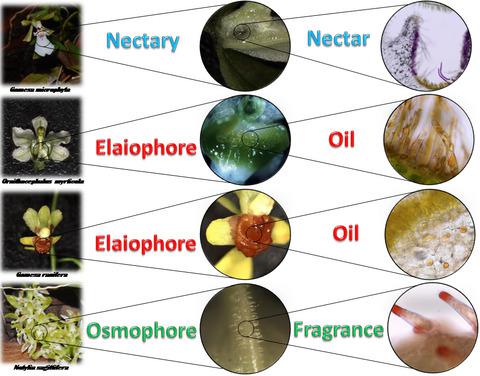当前位置:
X-MOL 学术
›
Plant Biol.
›
论文详情
Our official English website, www.x-mol.net, welcomes your
feedback! (Note: you will need to create a separate account there.)
So small and so rich: diversity of floral resources in miniature Oncidiinae (Orchidaceae) and their relation to pollinators
Plant Biology ( IF 4.2 ) Pub Date : 2020-11-21 , DOI: 10.1111/plb.13221 L. M. Pansarin 1 , E. R. Pansarin 1 , I. Alves‐Dos‐Santos 2 , S. P. Teixeira 3
中文翻译:

如此小而如此丰富:微型Oncidiinae(兰科)的花卉资源多样性及其与授粉媒介的关系
更新日期:2020-11-21
Plant Biology ( IF 4.2 ) Pub Date : 2020-11-21 , DOI: 10.1111/plb.13221 L. M. Pansarin 1 , E. R. Pansarin 1 , I. Alves‐Dos‐Santos 2 , S. P. Teixeira 3
Affiliation

|
- Oncidiinae is one of the most important subtribes among the Neotropical orchids, with an enormous diversity of floral morphology and secretory structures. This subtribe attracts a diverse array of pollinators which explore a variety of floral resources of its flowers.
- In this paper we provide a detailed investigation of the floral anatomy of 32 species of micro Oncidiinae. We applied histochemical tests in order to determine the diversity of the glands and rewards. The diversity of secretory flower structures and rewards was related to the group of pollinators known for this subtribe.
- We verified that half of the species (16 species, 50%) secrete oil as a resource, being pollinated by female of solitary bees. Species of some distinct nectar‐secreting genera (four species, 12.5%) are pollinated by a range of nectar‐searching animals. Species of the genus Notylia (four species, 12.5%) release floral perfumes that reward male Euglossini bees. Most of the investigated species (six species, 18.75%) possess osmophores that are involved in pollinator attraction. Two species of Capanemia (6.25%) do not offer any floral reward, suggesting that pollination by food deception is involved.
- There are strong variations in the anatomy of reward‐producing structures and resources in Oncidiinae. The diversity of floral rewards affects the range of pollinators, which are related to the diversification of this subtribe throughout the Neotropics. The understanding of relationships between Oncidiinae species and their pollinators is crucial to our knowledge of the evolution of pollination systems in this huge plant family represented by the orchids.
中文翻译:

如此小而如此丰富:微型Oncidiinae(兰科)的花卉资源多样性及其与授粉媒介的关系
- Oncidiinae是新热带兰花中最重要的亚科之一,其花的形态和分泌结构种类繁多。该部落吸引了各种各样的传粉者,他们正在探究其花朵的各种花卉资源。
- 在本文中,我们提供了对32种微型Oncidiinae的花卉解剖学的详细研究。为了确定腺体和奖励的多样性,我们应用了组织化学测试。分泌性花的结构和奖励的多样性与该亚群中已知的授粉媒介群有关。
- 我们验证了一半的物种(16个物种,占50%)分泌油作为一种资源,被独居蜂的雌性授粉。一些独特的花蜜分泌属(4种,占12.5%)的物种被一系列花蜜搜寻动物授粉。Notylia属的一个物种(四种,占12.5%)释放出花香的香水,奖励雄性Euglossini蜜蜂。大多数被调查物种(六个物种,占18.75%)具有与授粉媒介吸引力有关的渗透物。两种碳酸血症(6.25%)没有提供任何花香的奖励,表明其中涉及通过食物欺骗进行的授粉。
- 在Oncidiinae中,奖励产生结构和资源的解剖结构存在很大差异。花形奖励的多样性影响授粉媒介的范围,这与整个新热带地区该子部落的多样化有关。了解Oncidiinae物种及其授粉媒介之间的关系,对于我们了解以兰花为代表的庞大植物家族中授粉系统进化的知识至关重要。











































 京公网安备 11010802027423号
京公网安备 11010802027423号